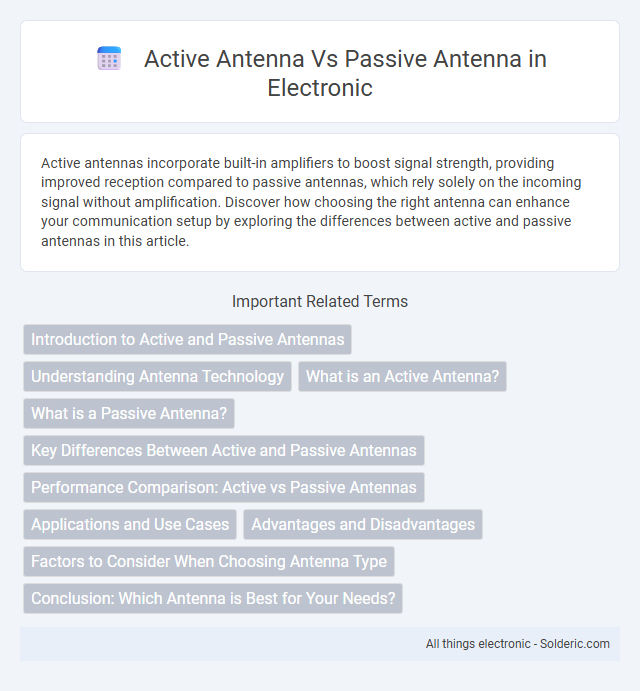Active antennas incorporate built-in amplifiers to boost signal strength, providing improved reception compared to passive antennas, which rely solely on the incoming signal without amplification. Discover how choosing the right antenna can enhance your communication setup by exploring the differences between active and passive antennas in this article.
Comparison Table
| Feature | Active Antenna | Passive Antenna |
|---|---|---|
| Definition | Contains built-in amplifier to boost signal strength | No built-in amplification; purely radiates or receives signals |
| Signal Gain | High signal gain due to internal amplifier | Limited to antenna design and size |
| Power Requirement | Requires external power source for amplifier | No power source needed |
| Noise Figure | Lower noise figure; improves signal quality | Depends on external components, typically higher noise |
| Complexity | More complex; includes electronics and power circuitry | Simple design; fewer components |
| Cost | Higher due to active components | Lower cost and maintenance |
| Applications | Used in weak signal environments like satellite or cellular networks | Common in broadcast and basic reception scenarios |
| Durability | Potentially lower due to electronic parts | Generally higher due to simple structure |
Introduction to Active and Passive Antennas
Active antennas incorporate an integrated amplifier that boosts signal strength, enhancing reception quality in low-signal environments, while passive antennas rely solely on their physical design and surrounding environmental factors to capture signals without additional amplification. Your choice between active and passive antennas depends on the specific application needs, signal environment, and power availability. Understanding the operational differences helps optimize performance in wireless communication systems, satellite reception, or broadcast applications.
Understanding Antenna Technology
Active antennas incorporate built-in amplifiers to boost signal strength, enhancing reception sensitivity especially in weak signal areas, while passive antennas rely solely on their design and size without electronic amplification. The integration of low-noise amplifiers in active antennas allows for improved signal-to-noise ratio, making them ideal for applications requiring long-range communication and better data quality. In contrast, passive antennas are simpler, more durable, and cost-effective, often preferred in environments where amplification is unnecessary or external amplification devices are used.
What is an Active Antenna?
An active antenna integrates an amplifier or transceiver directly within the antenna structure to enhance signal strength and improve overall reception quality. It requires a power source to operate its internal electronics, often leading to better performance in weak signal environments compared to passive antennas. This design reduces signal loss over cables and enhances sensitivity, making active antennas ideal for applications such as GPS, cellular networks, and satellite communication.
What is a Passive Antenna?
A passive antenna is a type of antenna that does not contain any active electronic components or amplifiers, relying solely on the electromagnetic waves it receives or transmits. Its operation depends entirely on the physical properties such as length, shape, and material, which determine its efficiency and frequency range. Understanding the characteristics of a passive antenna can help you select the right antenna for applications where simplicity and low power consumption are essential.
Key Differences Between Active and Passive Antennas
Active antennas integrate an internal amplifier that enhances signal strength, improving reception quality especially in weak signal areas, whereas passive antennas rely solely on their physical design without amplification. Active antennas require an external power source to operate the built-in amplifier, while passive antennas function without any power supply, making them simpler and more durable. Key differences include the signal gain provided by active antennas, which boosts overall performance, compared to the lower cost, lower maintenance, and broader frequency range typically associated with passive antennas.
Performance Comparison: Active vs Passive Antennas
Active antennas outperform passive antennas by integrating low-noise amplifiers directly at the antenna element, enhancing signal sensitivity and reducing noise figure. Passive antennas rely solely on the antenna's gain and external amplifiers, which can introduce additional signal loss and degrade overall performance. High-frequency applications and weak signal environments benefit significantly from active antenna designs due to improved signal-to-noise ratio and extended range capabilities.
Applications and Use Cases
Active antennas, equipped with built-in amplifiers, excel in applications requiring signal boosting and enhanced sensitivity, such as cellular base stations, GPS receivers, and remote sensing equipment. Passive antennas, lacking amplification components, are widely used in simpler systems like television broadcasting, FM radio, and basic Wi-Fi routers where signal strength is sufficient without electronic enhancement. Each antenna type is chosen based on the need for signal range, environmental conditions, and power availability in telecommunications, navigation, and IoT deployments.
Advantages and Disadvantages
Active antennas integrate an amplifier to boost signal strength, offering improved reception in weak signal areas and enhancing overall system performance. However, they require a power source, can introduce noise, and may degrade signal quality if the amplifier is of poor quality. Passive antennas rely solely on their physical design without amplification, providing reliable performance with minimal maintenance and no power needs, but they often struggle with weak signals and have limited range compared to active antennas.
Factors to Consider When Choosing Antenna Type
Choosing between an active antenna and a passive antenna depends on several critical factors such as signal amplification needs, power availability, and environmental conditions. Active antennas incorporate built-in amplifiers to boost weak signals, making them ideal for areas with low signal strength, whereas passive antennas rely solely on external equipment for signal gain. Consider the installation cost, maintenance requirements, and potential interference impacts before selecting the antenna type that best matches your communication system's performance and reliability goals.
Conclusion: Which Antenna is Best for Your Needs?
Active antennas are ideal for environments with weak signal reception due to their built-in amplifiers that boost signal strength and improve clarity. Passive antennas, with no power source or amplification, offer simplicity, reliability, and lower maintenance, making them suitable for strong signal areas and cost-sensitive applications. Choosing the best antenna depends on your specific needs for signal strength, installation environment, and budget considerations.
Active Antenna vs Passive Antenna Infographic

 solderic.com
solderic.com